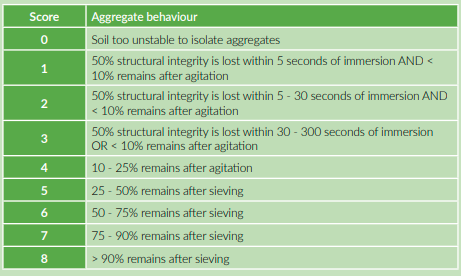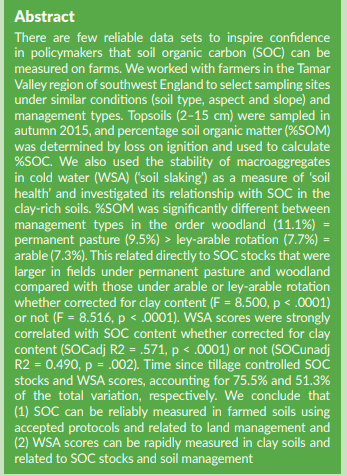Written by Jenni Dungait
Soil health and flood management:
New research1 led by Soil Health Expert Prof Jenni Dungait and scientists in the UK and the USA shows clear links between the last time a field was tilled, the amount of carbon in the soil, and the potential for soil to slake when wet. In a unique collaboration, the science team worked with farmers around the Tamar Valley in southwest England who belong to the Tamar Valley Organic Group and received funding from the Westcountry Rivers Trust. Abstract from the paper and link to it are included below.
Climate change is causing a wetter and warmer climate in the UK
October 2020 was the 5th wettest since 18622. Farmers across the UK are looking for solutions to prevent their fields from flooding during another winter as climate change causes warmer and wetter weather across the country. Apart from the obvious problems caused by flooding when crops die sitting under water, other pests such as slugs like wet soils, and black grass and other weeds need a good drink before they can germinate. Good soil drainage is essential to avoid flooding, especially in fields with heavy soils that are at risk of compaction caused by vehicle wheeling and livestock. Installing and maintaining field drains is vital to deal with increasing rainfall, and mechanical soil loosening may be necessary if there is compaction deeper in the soil profile, but farmers can also help by improving soil structure so that it drains more quickly by increasing soil carbon.
Soil carbon can be measured on farms
Farmers are often told that it is too difficult to measure soil carbon on farms although soil scientists have been doing it for decades. For example, the national Soil Surveys of England and Wales, and Scotland have reported soil carbon values for different habitats about every 10 years since the 1990s. In this project, we also successfully measured soil carbon in the fields belonging to farmers.
Soils under permanent pasture and woodland contain more carbon than soils under arable and ley-arable rotation
management
Our measurements showed that long term permanent pasture can hold as much carbon in the topsoil as woodlands, but that any sort of tillage stops carbon building up even if there were ley-periods of up to 3 years between cultivations.
The amount of soil carbon is directly related to the last time a field was tilled
Farmers want to know how long it takes to build up soil carbon to its maximum amount. Our study showed that disturbing the soil by ploughing or other types of tillage causes large losses of topsoil carbon, and that the carbon starts to build up again when the tillage stops.
Because we looked at fields managed in different ways on each farm in the project and the farmers knew when the fields were last ploughed, we could estimate that it takes about 30 years to reach maximum soil carbon after a field that was used for intensive arable production is converted to permanent pasture or woodland.

The slake test can be used as a good soil health indicator
In this project, the ‘soil slake test’ was developed by Dr Sarah Collier who is a soil scientist who works with farmers in the USA. She used an established test used regularly by farmers across the USA and adapted it for the heavy clay soils of Devon and Cornwall. This is how the aggregate slaking was measured and scored: air-dried aggregates are placed on a sieve and put into cold water (simulating a flooded soil). Their behaviour is scored from 0-8 depending on whether the aggregates stay intact, and how much soil remains on the sieve: Our work found that the soil slake test score is directly related to the amount of soil carbon in the topsoil, and therefore also to the length of time since a field was tilled. This makes this test a great way to measure how soil carbon is affected by soil management.
How does this information help farmers cope with flooding?
Heavy soils can slump naturally if they are flooded with water. The water moving into the soil pushes out the air held in the soil structure allowing the soil to collapse in on itself, effectively sealing the soil. You can see this happening for yourself if you do the soil slake test using aggregates taken from the soil.
Soil slaking and soil carbon
Soil with a good structure crumbles easily in your hand into rounded peds or aggregates that maintain their shape in water. We found that the more carbon was in a soil, the more stable soil aggregates were in cold water. Soil carbon plays a major role in keeping soil structure in good shape to allow water to drain and move through the soil. Farmers can build soil carbon by avoiding unnecessary tillage, and particularly avoid having bare soil, by growing cover crops, retaining crop residues, and applying composts and animal manures. This is also food for beneficial soil biology like earthworms whose burrows act as vertical drainage channels.

References
1 Collier, SM, Green, SM, Inman, A, et al. Effect of farm management on topsoil organic carbon and aggregate stability in water: A case study from Southwest England, UK. Soil Use Manage. 2020; 00: 1– 14. https://doi.org/10.1111/sum.12658
2 https://blog.metoffice.gov.uk/2020/11/03/uk-sees-fifth-wettestoctober-since-1862/